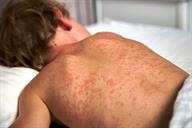Measles, Pediatric
Measles, also called rubeola, is an illness that causes a red skin rash. It's contagious, which means it spreads easily from person to person. Measles can be very serious if your child is younger than 5 years of age.
What are the causes?
Measles is caused by a germ called a virus. The germ infects your child's respiratory system. This includes their nose, throat, windpipe, and lungs. Then it spreads to the rest of their body. Your child can get measles by:
Breathing in droplets from an infected person's cough or sneeze.
Touching something that has the germ on it and then touching their mouth, nose, or eyes.
What increases the risk?
Your child is more likely to get measles if:
What are the signs or symptoms?

Measles symptoms often start 8–10 days after your child comes in contact with the germ. Symptoms may include:
Fever.
White spots in the mouth.
Red, runny eyes that may be extra sensitive to light.
Sneezing or coughing.
A sore throat.
A red rash that starts on the face and spreads to the body.
The rash is the last symptom to form. It lasts 3–5 days. In rare cases, there's no rash.
How is this diagnosed?
Measles may be diagnosed based on your child's symptoms, medical history, and an exam. Your child may also have tests. These may include:
How is this treated?
Measles goes away on its own in about 2 weeks. But treatment can help your child feel better while they heal. It can also help prevent other problems. Your child may need:
Rest.
Lots of fluids. In some cases, your child may need to get fluids through an IV.
Medicines to reduce itching and fever.
Vitamin A.
Antibiotics, if they get an infection.
Follow these instructions at home:
Medicines
-
Give your child medicines only as told by your child's health care provider.
-
Do not give your child aspirin. Aspirin is linked to Reye's syndrome in children.
-
Do not give your child ibuprofen if they're younger than 6 months old.
-
If your child was given antibiotics, give the antibiotics as told by the provider. Do not stop giving the antibiotics even if your child starts to feel better.
Managing itching, pain, and discomfort
- To help with itching:
Put cold, wet cloths called cold compresses on your child's skin.
Put calamine lotion on your child's skin.
Give your child a cool bath. Try adding baking soda or dry oatmeal to the water. Do not give your child a bath in hot water.
Keep your child cool and out of the sun. Sweating and being hot can make itching worse.
- If your child has blisters in their mouth:
Do not give them foods and drinks that are spicy, salty, or have acid in them.
Soft, bland, and cold foods and drinks are best.
-
Do not let your child scratch or pick at the rash. To help stop scratching:
Preventing infection of others
General instructions
-
Make sure your child drinks enough fluid to keep their pee pale yellow.
-
Keep the lights low if bright lights bother your child.
-
Keep a humidifier in your child's room. This can help with their cough.
-
You may get a call from the public health department. They may ask how your child got measles.
How is this prevented?
Measles can be prevented with a vaccine shot.
If your child hasn't gotten the shot, they may be able to get it within 6 days of being around someone with measles.
If your child has had measles before, they can't get it again. They don't need the shot.
Babies younger than 6 months old can't get the shot.
Contact a health care provider if:
-
Your child has ear pain or fluid coming from their ear.
-
Your child has a headache.
-
Your child has nausea or vomiting.
-
Your child's symptoms don't go away in 2 weeks.
-
Your child has symptoms of another illness.
-
Your child is weak or dizzy.
-
Your child's pee is a darker color than normal.
-
Your child pees less often or has fewer wet diapers than normal.
-
Your child vomits each time they drink, and this lasts for more than a few hours.
-
Your child pees only a small amount of very dark pee in 6–8 hours.
-
Your child has a fever, and their symptoms get worse all of a sudden.
-
Your child is younger than 3 months and has a temperature of 100.4°F (38°C) or higher.
-
Your child is short of breath or breathing very fast.
-
Your child has chest pain.
-
Your child is confused, extra sleepy, or has a seizure.
These symptoms may be an emergency. Do not wait to see if the symptoms will go away. Call 911 right away.
This information is not intended to replace advice given to you by your health care provider. Make sure you discuss any questions you have with your health care provider.
 Measles symptoms often start 8–10 days after your child comes in contact with the germ. Symptoms may include:
Measles symptoms often start 8–10 days after your child comes in contact with the germ. Symptoms may include: